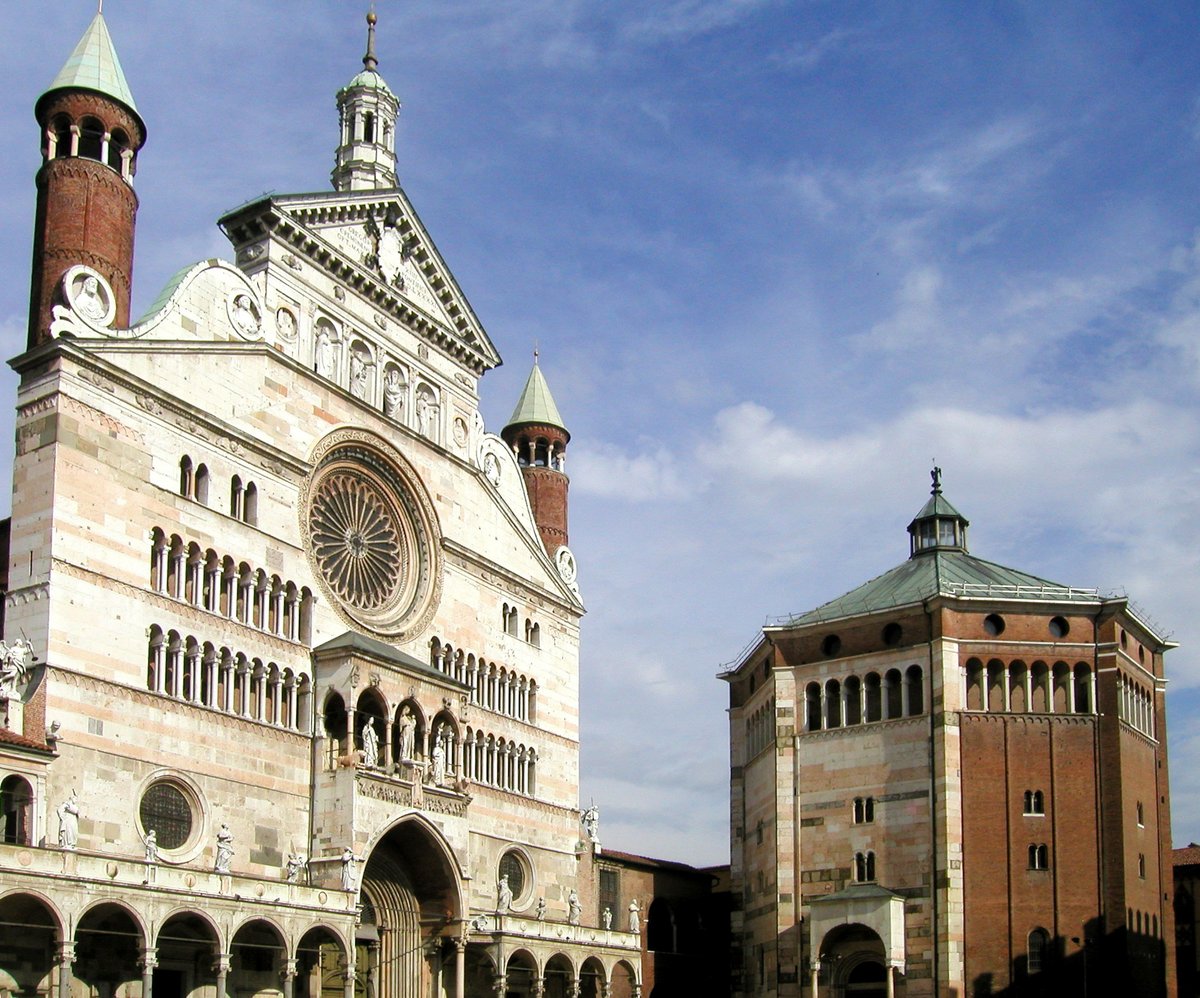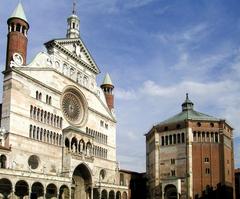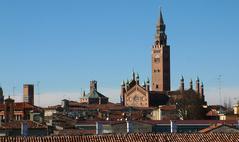
Comprehensive Guide to Visiting Battistero, Cremona, Italy
Date: 31/07/2024
Introduction
Nestled in the heart of northern Italy, the Battistero di Cremona, or Cremona Baptistery, stands as a monumental testament to medieval religious architecture. Constructed in 1167, this octagonal edifice is annexed to Cremona’s Cathedral and serves as a profound symbol of the cult of St. Ambrose of Milan. Its unique blend of Romanesque solidity and Lombard-Gothic elements reflects the architectural transitions and innovations of its time, making it a significant historical and cultural landmark (Wikipedia, Italy Magazine).
The Baptistery’s interior is adorned with notable artworks, including a 14th-century Crucifix and wooden statues by Giovanni Bertesi, enhancing its spiritual ambiance. Over the centuries, the structure has undergone several restorations, particularly in the 16th century, which have preserved its original elements while introducing new features that augment its aesthetic and functional aspects (Wikipedia, Italy Magazine).
Beyond its architectural and artistic significance, the Battistero di Cremona holds deep civic and social importance, reflecting the broader religious and social developments of the Middle Ages and the Renaissance. Its construction was driven by the rapid urban development and the enduring significance of baptism during these periods (CAA Reviews). Today, it continues to attract visitors from around the world, serving as a vital part of Cremona’s cultural and religious heritage (Travel Savvy Gal).
Table of Contents
- [Origins and Early Construction](#origins-and-early-constructionorigins-and-early-construction)
- [Architectural Styles and Influences](#architectural-styles-and-influencesarchitectural-styles-and-influences)
- [16th Century Restorations](#16th-century-restorations16th-century-restorations)
- [Interior Art and Decorations](#interior-art-and-decorationsinterior-art-and-decorations)
- [Civic and Social Significance](#civic-and-social-significancecivic-and-social-significance)
- [Architectural Evolution and Rituals](#architectural-evolution-and-ritualsarchitectural-evolution-and-rituals)
- [Comparative Analysis with Other Baptisteries](#comparative-analysis-with-other-baptisteriescomparative-analysis-with-other-baptisteries)
- [Preservation and Modern-Day Significance](#preservation-and-modern-day-significancepreservation-and-modern-day-significance)
- [Visitor Experience and Travel Tips](#visitor-experience-and-travel-tipsvisitor-experience-and-travel-tips)
- [Opening Hours and Admission](#opening-hours-and-admissionopening-hours-and-admission)
- [Best Time to Visit](#best-time-to-visitbest-time-to-visit)
- [Getting There](#getting-theregetting-there)
- [Guided Tours](#guided-toursguided-tours)
- [What to Wear](#what-to-wearwhat-to-wear)
- [Photography](#photographyphotography)
- [Nearby Attractions](#nearby-attractionsnearby-attractions)
- [Dining Options](#dining-optionsdining-options)
- [Accessibility](#accessibilityaccessibility)
- [Safety Tips](#safety-tipssafety-tips)
- [Souvenirs](#souvenirssouvenirs)
- [Language](#languagelanguage)
- [Emergency Contacts](#emergency-contactsemergency-contacts)
- [FAQ](#faqfaq)
- [Conclusion](#conclusionconclusion)
- [Stay Up to Date](#stay-up-to-datestay-up-to-date)
Origins and Early Construction
The Cremona Baptistery, known in Italian as the Battistero di Cremona, is a significant religious edifice located in Cremona, northern Italy. It was constructed in 1167 and is annexed to the city’s Cathedral. The octagonal plan of the Baptistery is a reference to the cult of St. Ambrose of Milan, symbolizing the Eight Day of Resurrection and, by extension, the rite of Baptism (Wikipedia).
Architectural Styles and Influences
The Baptistery is a fascinating blend of Romanesque and Lombard-Gothic architectural styles. The Romanesque influence is evident in the structure’s robust and solid form, while the Lombard-Gothic style is showcased through the preference for bare brickwork walls. This combination of styles reflects the architectural transitions and innovations of the period (Italy Magazine).
16th Century Restorations
Significant restorations took place in the 16th century, which included the addition of a marble cover to some of the walls, the pavement, and the baptismal font, which was completed in 1531. The narthex of the entrance, designed in Romanesque style by Angelo Nani, was added in 1588. These restorations not only preserved the original architectural elements but also introduced new features that enhanced the aesthetic and functional aspects of the Baptistery (Italy Magazine).
Interior Art and Decorations
The interior of the Baptistery houses several notable artworks. A 14th-century Crucifix is prominently displayed over the St. John altar. Additionally, there are two wooden statues portraying St. Philip Neri and St. John the Baptist, crafted by Giovanni Bertesi. Over the ceiling, a 12th-century statue of the Archangel Gabriel adds to the historical and artistic value of the interior space (Wikipedia).
Civic and Social Significance
The evolution of the Baptistery’s structure is closely linked to broader social and religious developments during the Middle Ages and the Renaissance. The construction of baptisteries in northern and central Italy during these periods was driven by rapid urban development and the continuing significance of baptism. The institutional influence of late medieval Italian bishoprics also played a crucial role in the proliferation of these structures (CAA Reviews).
Architectural Evolution and Rituals
The architectural evolution of the Baptistery is not just a reflection of changing styles but also of the evolving rituals associated with baptism. The structure served as a setting for the rite of baptism, which was a significant religious and social event. The design and decoration of the Baptistery were intended to enhance the spiritual experience of the participants, making it a place where art, architecture, and emotions intersect (CAA Reviews).
Comparative Analysis with Other Baptisteries
The Cremona Baptistery stands out among other baptisteries in Italy due to its unique blend of architectural styles and its historical significance. While many baptisteries from the same period exhibit similar Romanesque and Gothic influences, the Cremona Baptistery’s octagonal plan and specific decorative elements make it a distinctive example of medieval religious architecture (Lonely Planet).
Preservation and Modern-Day Significance
Today, the Cremona Baptistery continues to be a vital part of the city’s cultural and religious heritage. Efforts to preserve and maintain the structure ensure that it remains a significant historical site for future generations. The Baptistery not only attracts tourists but also serves as a reminder of the rich architectural and religious history of Cremona (Travel Savvy Gal).
Visitor Experience and Travel Tips
Visitors to the Cremona Baptistery can appreciate its historical and architectural significance through guided tours and informational displays. The structure’s proximity to other notable sites in Cremona, such as the Cathedral and the Torrazzo Bell Tower, makes it an essential stop for anyone exploring the city. The combination ticket for the Cathedral complex allows visitors to experience the full historical and cultural context of the Baptistery (Dan Flying Solo).
Travel Tips:
- Visiting Hours: The Baptistery is open daily from 9:00 AM to 6:00 PM.
- Tickets: A combination ticket for the Cathedral complex, including the Baptistery, costs around €10 for adults.
- Nearby Attractions: The Cremona Cathedral, Torrazzo Bell Tower, and the Violin Museum are all within walking distance.
Opening Hours and Admission
The Battistero di Cremona, also known as the Baptistery of Cremona, is typically open to visitors from 10:00 AM to 5:00 PM. However, these hours can vary depending on the season and special events, so it is advisable to check the official website or contact the local tourist office for the most up-to-date information. Admission fees are generally modest, with discounts available for students, seniors, and groups. Children under a certain age may enter for free.
Best Time to Visit
The ideal times to visit Cremona, including the Battistero, are during the shoulder seasons of mid-April to mid-June and September. During these periods, the weather is pleasant, making it perfect for walking tours and outdoor activities. Early June and early September are particularly favorable as they offer comfortable temperatures and fewer crowds (Savoring Italy).
Getting There
Cremona is easily accessible from major cities like Milan. If you are driving, it takes about 1 hour and 8 minutes via the A21 autostrada. Parking is available in large lots just outside the city center, from where it is a short walk to the Battistero and other attractions (Savoring Italy). Alternatively, Cremona is well-connected by train, making it a convenient day trip from Milan or other nearby cities.
Guided Tours
For a more enriching experience, consider joining a guided tour. Several options are available, including:
- Cremona: City of Art and Music: This walking tour covers top spots like the Cathedral, Baptistery, and Torrazzo, and includes insights into Cremonese lutherie.
- Cremona Private City Tour with Licensed Tour Guide: This tour allows you to explore at your own pace with a licensed guide, offering deep insights into Cremona’s culture.
- Cremona: Private Half Day City Tour: Ideal for those short on time, this tour hits the highlights like the Cathedral and Violin Museum (Savoring Italy).
What to Wear
Given the religious significance of the Battistero, it is advisable to dress modestly. Shoulders and knees should be covered, and hats should be removed upon entering. Comfortable walking shoes are recommended, as the historic center of Cremona is best explored on foot.
Photography
Photography is generally allowed inside the Battistero, but it is always best to check for any specific restrictions upon arrival. Flash photography may be prohibited to protect the delicate frescoes and architectural details.
Nearby Attractions
While visiting the Battistero, make sure to explore other nearby attractions:
- Cattedrale di Cremona: Adjacent to the Battistero, this Romanesque cathedral boasts stunning frescoes and a magnificent façade (Lonely Planet).
- Torrazzo di Cremona: One of the tallest medieval brick towers in Europe, offering breathtaking views from the top and featuring an impressive astronomical clock (Savoring Italy).
- Museo del Violino: A must-visit for music lovers, this museum showcases violins made by legends like Stradivari and delves into the history of violin-making in Cremona (Savoring Italy).
Dining Options
Cremona offers a variety of dining options to suit all tastes and budgets. Local specialties include gran bollito misto, a delicious stewed beef dish, and torrone, a sweet nougat. For a more immersive experience, consider dining at local trattorias and osterias to savor authentic Cremonese cuisine (Savoring Italy).
Accessibility
The Battistero di Cremona is generally accessible to visitors with mobility issues, although some areas may present challenges due to the historic nature of the building. It is advisable to contact the site in advance to inquire about specific accessibility features and accommodations.
Safety Tips
Cremona is a relatively safe city, but it is always wise to take standard precautions. Keep an eye on your belongings, especially in crowded areas, and be aware of your surroundings. If you are traveling by car, do not leave valuables visible inside the vehicle.
Souvenirs
Before leaving, consider purchasing some local souvenirs. Popular items include handcrafted violins, local wines, and culinary delights like torrone and mostarda. These make for excellent gifts and mementos of your visit to Cremona.
Language
While Italian is the primary language spoken in Cremona, many people in the tourism industry speak English. However, learning a few basic Italian phrases can enhance your experience and is always appreciated by locals.
Emergency Contacts
In case of emergencies, the following numbers are essential:
- Police: 112
- Ambulance: 118
- Fire Department: 115
Having these numbers handy can provide peace of mind during your visit.
FAQ
Q: What are the visiting hours for the Cremona Baptistery?
A: The Baptistery is open daily from 9:00 AM to 6:00 PM.
Q: How much are the tickets for the Cremona Baptistery?
A: A combination ticket for the Cathedral complex, including the Baptistery, costs around €10 for adults.
Q: What are some nearby attractions to the Cremona Baptistery?
A: Nearby attractions include the Cremona Cathedral, Torrazzo Bell Tower, and the Violin Museum.
Conclusion
The Cremona Baptistery is a remarkable example of medieval religious architecture, reflecting the architectural innovations and social significance of its time. Its blend of Romanesque and Lombard-Gothic styles, coupled with its rich history and artistic decorations, make it a must-visit site for anyone interested in the architectural and cultural heritage of Italy. The ongoing preservation efforts ensure that this historical edifice continues to inspire and educate visitors from around the world (Trip Savvy).
Stay Up to Date
For more information and updates on the Cremona Baptistery, follow us on social media or download the Audiala app. Check out our related posts for more insights into Italy’s rich cultural heritage.
References
- Wikipedia. (n.d.). Cremona Baptistery. Wikipedia
- Italy Magazine. (n.d.). Cremona Baptistery. Italy Magazine
- CAA Reviews. (n.d.). Reviews. CAA Reviews
- Travel Savvy Gal. (n.d.). Spend One Day in Cremona, Italy. Travel Savvy Gal
- Dan Flying Solo. (n.d.). Cremona Italy Travel. Dan Flying Solo
- Domusweb. (2023). Maurizio Cattelan hung a crocodile in the baptistery of Cremona. Domusweb
- Turismo Cremona. (n.d.). La Cattedrale, il Torrazzo e il Battistero. Turismo Cremona

